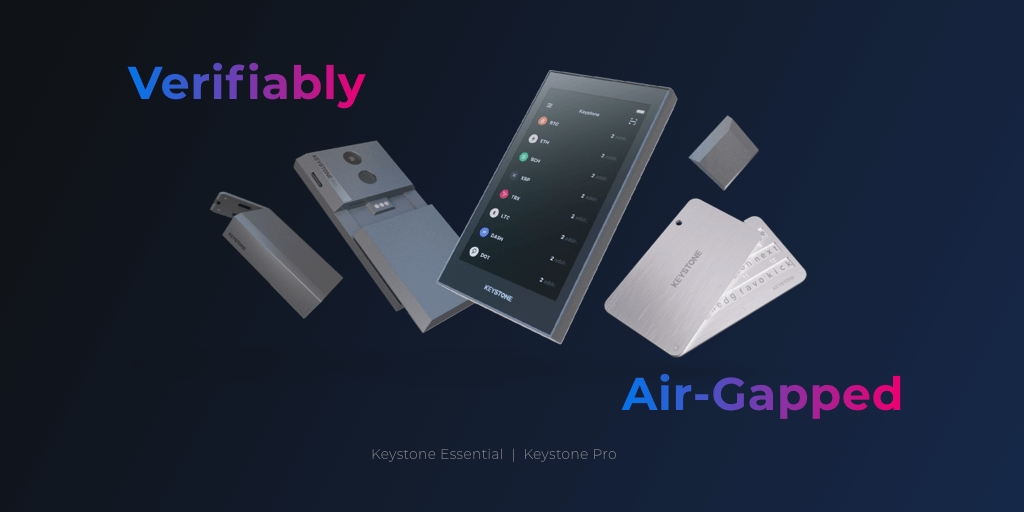About Keystone

Keystone Hardware Wallet is a 100% Air-gapped QR code communication hardware wallet for Bitcoin, Ethereum, USDT, BCH, XRP, Tron, LTC, Dash, Polkadot, Kusama and 1000+ cryptocurrencies.
It offers convenient cold storage solution with an open source firmware, 4 inch touchscreen and PSBT Bitcoin multisig support. Protect your cryptocurrency with the perfect balance between secure and convenient hardware wallet with mobile phone support.
These are the full feature highlights of the Keystone Essential and Pro.

All hardware wallets need some means of connecting to the network to sign transactions; how “air-gapped” your hardware wallet is depends on how it limits the attack surface when transmitting data to an internet-enabled device. QR codes have a smaller attack surface than USB, NFC, and Bluetooth, making them the perfect means of data transmission for an air-gapped hardware wallet. We have pioneered an animated QR code solution that enables transmission of larger amounts of transaction data and have also developed microSD card capability as requirements for compatibility with desktop wallets like Electrum and Wasabi are more demanding.

With QR codes, you can verify each and every data transmission to ensure that information coming into the Keystone Hardware Wallet contains no trojans or viruses and information going out doesn’t leak private keys or any other sensitive information. In contrast to USB or Bluetooth, QR codes are entirely verifiable as any normal QR code scanner can convert their data contents into human-readable format.

Keystone Hardware Wallet uses a bank-grade Secure Element to generate true random numbers, derive private and public keys, sign transactions, and protect private keys from being leaked if an attacker has physical access to the device. In addition to ensuring your keys really are your keys by sourcing them from physical entropy, a Secure Element is vital to storing your private keys with the best possible protection from physical attack. A hardware wallet equipped with a Secure Element is a foundation of security long-term hodlers can rely on.

Keystone Hardware Wallet is the first hardware wallet to have open source Secure Element firmware code, which allows you to verify all core cryptographic operations such as how private keys are generated and contained entirely within the Secure Element. You are able to compile the open source Secure Element firmware and hardware wallet application layer code available on our Github page if you want to verify the genuinity of firmware upgrade packages for Keystone Essential and Pro yourself. We have also released the device schematic circuit diagram.

The weakest link in an electronic device tends to be the battery because it’s usually only built to last a few years. Keystone batteries are detachable to prevent corrosion damage and both Keystone Essential and Pro come with AAA battery support so you never have to worry about battery failure down the road. Keystone Pro also comes with a rechargeable battery.
Be aware AAA battery voltage is not steady, which is why it is generally used for products that do not need a constant voltage, like remote controllers. The AAA battery support option is intended for infrequent use. If you are likely to turn on your hardware wallet more than a couple of times a month, we recommend getting Keystone Pro.

More sophisticated hardware wallet owners may have multiple devices used for different purposes. Keystone Pro has a fingerprint sensor option that can be used to take care of business in public locations like cafes or airports to prevent your passwords from being stolen by onlookers or surveillance cameras. Fingerprint authentication for device unlock and transaction signing can be toggled off in settings at the user’s discretion.

Hardware wallets are more vulnerable when you take them around with you. To prevent a side-channel attack from succeeding if you lose your device, we designed a multilayered self-destruct mechanism for Keystone Pro. Upon detection of disassembly, the self-destruct mechanism will wipe the private keys and any sensitive information so that an attacker cannot extract it from your device.

Keystone Hardware Wallet supports BTC, ETH, USDT, BCH, XRP, TRON, LTC, DASH, DOT and KSM. ETH and TRX tokens are also supported. View our full list of supported coins and tokens here. If you are interested in a Bitcoin-only hardware wallet, a Bitcoin-only firmware version for upgrading Keystone Essential and Pro is also available.

Keystone Essential is intended for long-term hodlers and comes with AAA battery support for 119 USD. Keystone Pro is designed for more portable access to funds and comes with a rechargeable battery, fingerprint sensor, and self-destruct mechanism for 169 USD. Shipping is free to the United States and Canada.
Final Words
our Absolute 100% security may not exist, but that doesn’t mean it shouldn’t be the ideal that we strive for. These features reflect our vision for improving hardware wallets and our commitment to staying apace of developments in the community. To learn more about our approach to building hardware wallets, please read our article on Keystone’s design principles.
If you have other features you would like to see us develop, you can send an email to [email protected].
All Keystone models support Web Authentication, a process that ensures product authenticity. We highly recommend you complete Web Authentication when you receive your device to prevent supply chain attacks.
Give us a shoutout on Twitter @KeystoneWallet if you have any questions or comments about our product and follow us to stay updated with all the upcoming feature releases.
Last updated
Was this helpful?